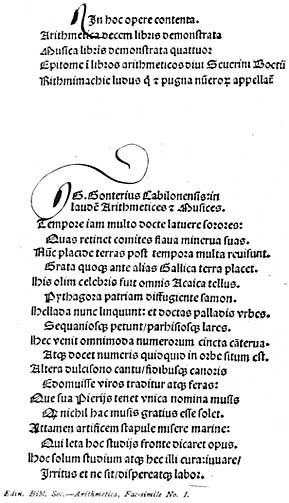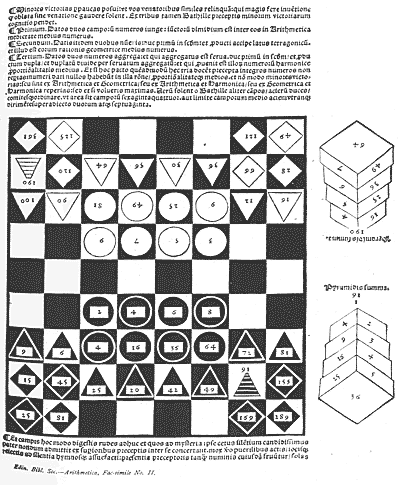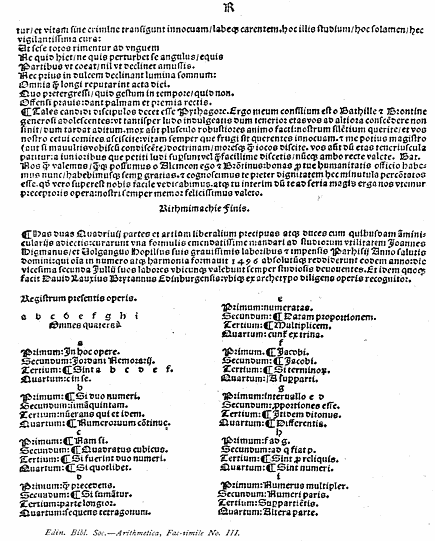
Facsimile no.1
(Enlargement)

BY JOHN SCOTT, C. B.
| T |
---------------------------
* I. Multorum vocabulorum equivocorum interpretatio Magistri Johannis de Garlandia, &c. 4to, 1505. (Without place, but printed at Rouen for Andrew Myllar.) II. Expositio Sequentiarum, seu Prosarum secundum usum Sarum. 4to, 1506. (With device of Andrew Myllar, but printed at Rouen by L. Hostingue.)
---------------------------
printed in France, bearing the name of Andrew Myllar, has awakened a new interest in the question of early printing by Scotsmen.
At the date of the publication of Dr Dickson's work, it appears that the honour of being the first Scotsman connected with the art of printing rested with Andrew Myllar. The object of this paper is to state some facts which seem to warrant the conclusion that the claim of another Scotsman for the possession of so honourable a position has been overlooked.
In the year 1496, respectively five and six years prior to the issue of the two French books bearing Andrew Myllar's name, there was printed at Paris a collection of Treatises on Arithmetical and Musical subjects. It bears on the first leaf the following short title (see Facsimile No. I):—
|
Arithmetica decem libris demonstrata Musica libris demonstrata quatuor Epitome in libros arithmeticos divi Seuerini Boetii Rithmimachie ludus quod et pugna numerorum appellatur." |
/ p.2 /
The verso of the first leaf contains a dedication; the first treatise, commencing on sign a2, is printed on forty leaves, ending on e8, with irregular pagination in Roman letters on recto of each leaf, I occurring on three leaves, II, III, IIII following, each on three leaves respectively, V on two leaves, VI on four leaves, VII on five leaves, VIII on four leaves, VIIII on eight leaves, X on four leaves.
The second treatise, commencing on f1, has a similar system of pagination, but the verso of each leaf has, in addition, a Gothic letter M at top of the page, ending on verso of h6. The recto of h7 is blank. The third treatise, commencing on verso of h7, has no pagination, but the verso of each leaf has a Gothic letter E at the top of the page. It ends on the middle of verso of sign i6. The fourth treatise, commencing with a short interval on that page, has no pagination, but the Gothic letter R on the last two leaves, as may be seen on referring to Facsimile No. 3.
(1.) The first of the treatises named in the title — Elementa Arithmetica of Jordanus Nemorarius (and author over whose history some obscurity hangs, but who is believed to have written in the thirteenth century) — appears in the book with a commentary and demonstrations by Jacques Le Febvre d'Etaples, better known under his Latin name of Jacobus Faber Stapulensis, as the author of many works of a scientific description, which he commenced to publish at the end of the fifteenth century.
(2.) Le Febvre himself is the author of the second treatise, under the title of Elementa Musicalia, which is in reality a treatise on fractions under musical names.
(3.) The third treatise is an epitome by Le Febvre of the Arithmetical books of Severinus Boetius, the author of The Consolation of Philosophy. The Arithmetica of Boetius was printed for the first time at Venice by Erhard Ratdolt in 1488.
(4.) The fourth treatise, named Rithmimachie ludus, is a dialogue on the properties of numbers, with a curious diagram of an obscure kind of game played on a board resembling a chess-board, and intended to illustrate the properties of numbers (see Facsimile No. 2). This curious production has been attributed to Jordanus Nemorarius, and also to William Shirwood, Bishop of Durham, in the reign of Edward IV. It was printed separately at Rome in 1482, with a preface by that prelate, and in this form is a work of extreme rarity. There is a copy in the Grenville Library at the British Museum.
/ p.3 /
At the end of the fourth treatise is the following colophon (see Facsimile No. 3), which furnishes to Scotsmen the special point of interest in the book, and forms the basis of this paper:—
"Has duas Quadrivii* partes et artium liberalium precipuas atque duces cum quibusdam amminiculariis adjectis: curarunt una formulis emendatissime mandari ad studiorum utilitatem Joannes Higmanus et Wolgangus Hopilius suis gravissimis laboribus et impensis Parhisii Anno salutis domini: qui omnia in numero atque harmonia formavit 1496 absolutumque reddiderunt eodem anno: die vicesima secunda Jullii suos labores ubicunque valebunt semper studiosis devoventes. Et idem quoque facit David Lauxius Brytannus Edinburgensis: ubique ex Archetypo diligens recognitor."
---------------------------
This colophon may be translated as follows:—
Who was David Lauxius of Edinburgh, and what is the proper vernacular rendering of his Latinized name?
---------------------------
extending from the early part of the fifteenth century for two hundred years.
/ p.4 /
Whatever was his Scottish patronymic, it is evident that Lauxius must have ben a man of some culture and erudition, or he would have been entirely unfit to have filled the duty of reviser of the press for a work of so much intricacy. The duties of the "recognitor" must have been peculiarly arduous in the infancy of the art of printing. The accuracy with which the Jordanus Nemorarius is set up, and its general freedom from errors of the press, form a tribute to the skill with which David Lauxius performed his duties. The fact that he was connected with the printing office of Higman and Hopil, and employed on the works of Le Febvre, is another testimony to his merit, as that author was in the habit of eulogising those trusted with the printing of his books. At the end of the Physics of Aritotle, which the same printers issued in 1492, are to be found laudatory verses extolling the merits of their press.
* Boetius uses the word "quadrivium" to represent the four kindred mathematical sciences — Arithmetic, Music, Geometry, and Astronomy, two of which are treated of in this book.
---------------------------
As far as the writer is aware, no notice of Lauxius occurs in any other place. It is submitted that Lauxius is the Latinized form of the old Scottish surname of Law. There is probably no list of Scottish surnames, at least connected with France, of greater variety than those composing the rolls of the Scottish Life Guards and Men-at-Arms attached to the French Court,†
† The Scots Men-at-Arms and Life Guards in France, from their Formation until their Final Dissolution A.D. 1480-1830, by W. Forbes-Leith, S.I. Edinburgh, 1882. 2 vols. 4to.
---------------------------
Among the names on the rolls may be noticed, in 1473, that of Jehan Lau, and in 1498 Guillaume Lau, which seem without doubt, by the common interchange of u for w, to represent the name which later has been spelt as Law. It is not suggested that David Lauxius was one of the men-at-arms, but the rolls are referred to as a contemporary example of the French form of spelling an easily recognised surname. Many of the Scottish names on these rolls are not so easy of identification.
The duties of the "recognitor" in an early printing office brought him in close connection with its practical work, and he probably had the direct supervision of the compositors and pressmen.
As has been already indicated, no other mention has been found of Lauxius.
Shortly after the issue of the Jordanus Nemorarius, the partnership of Higman and Hopil terminated, and the latter became associated with Henri Estienne, or Henricus Stephanus, the founder of the famous line of printers bearing that name. Their first book, printed in 1503, was an edition of the Arithmetic of Severinus Boetius and the Astronomicon of Le Febvre. It bears as colophon:—
"Has duas quadrivii partes et artium liberalium precipuas atque duces cum quibusdam amminiculariis adjectis: curavit ex secunda recognitione una formulis / p.5 / emendatissime mandari ad studiorum utilitatem Henricus Stephanus suo gravissimo labore et sumptu Parhisiis Anno salutis domini: qui omnia in numero atque harmonia formavit 1514 absolutumque reddidit eodem anno: die septima Septembris suum laborem ubicunque valet semper studiosis devovens."
It will be observed that this colophon is an exact repetition of that of 1496, with the exception of the substitution of the name of Stephanus for that of Higman and Hopil, the introduction of the words "ex secunda recognitione," and the omission of the protion referring to David Lauxius.
The edition of 1496 has received scant notice from bibliographers. Panzer (Annales) gives the title and colophon in full without observation; Hain (Repert. Bibliog.) gives the title and colophon in full and a correct collation; Brunet (Manuel, Vol. III. p. 567) had apparently never seen a copy, and quotes Panzer as his authority for the short title and colophon, which he has not room to reprint. The only English bibliographer who has noticed the book is De Morgan (Arithmetical Books, London, 1847). He enters the various books, which he describes chronologically, and at the commencement of his list he had not evidently seen the first edition of Jordanus, as on page 4 he cites Le Febvre's Epitome of Boetius (Paris, Hopil and Stephanus, 1503) as the first edition of that treatise, and it is only in mentioning the second edition of 1514 that he refers to that of 1496. He says: "This second edition was printed by H. Stephens" (the first, Paris, 1496, was printed by Hopilius, whose partner H. Stephens afterwards was), "under the superintendence of David Lauxius of Edinburgh," and he adds the following note:—
"Capiat qui capere potest, is the only general principle on which names like this can be read back into the vernacular. I once found James Hume, well known as a mathematician, at Paris, in the beginning of the seventeenth century, described as Scotus Theagrius. What part of the Land of Cakes this might be would probably have eluded all the books in existence; but a Scottish friend to whom I mentioned my difficulty solved it at once by telling me that it must have been one of the Humes of Godscroft, a place in which certain Humes are, or were, lords of the soil."
Before De Morgan had finished printing his book, he had seen (probably in the British Museum) a copy of the edition of 1496, and in his Appendix, page 100, he says:—
"This is the first edition of the work mentioned in page 10, so I was wrong in page 4. I was misled by bibliographers mentioning this as an edition of Jordanus alone. The copy before me came to me in two different parts, though the Register at the end (which has the first words of all the sheets) proves that these parts belong to / p.6 / one work. It would be odd if it should have been customary to divide it in this manner, so as to lead to the above imperfect description. The corrector of the press was David Lauxius, and the printers John Higman and Wolfgang Hopilius."
De Morgan's interest lying principally in the subject of the book, and the fact of his being unacquainted with the history of Scottish printing, has no doubt been the reason of his omitting to claim for Lauxius his position as the first Scotsman connected with the printing of a book, a position which, it is submitted, is borne out by the facts stated in this paper.
It may be of interest to note some instances in which the Jordanus (1496) has appeared in sale catalogues. Brunet notes two sales occurring many years since. The Pinelli Sale Catalogue, London, 1787, describes a copy. A copy was sold at the Libri sale at Sotheby's, London, in 1861.
At the Yemeniz sale in Paris in 1867, the copy which has been exhibited to the Society, and from which the facsimiles in this paper have been taken, was sold to a Paris bookseller, and after several renewed appearances in auction rooms, reached its present possessor. At the sale of the library of Monsieur de Chasles, Member of the French Institute, at Paris in 1877, a copy, which was probably that of Libri mentioned above, was disposed of.
Two copies of the edition of 1496 are to be found in the British Museum (one imperfect). A copy of the second edition, 1514, is in the library of the Royal Society of London.


|
|